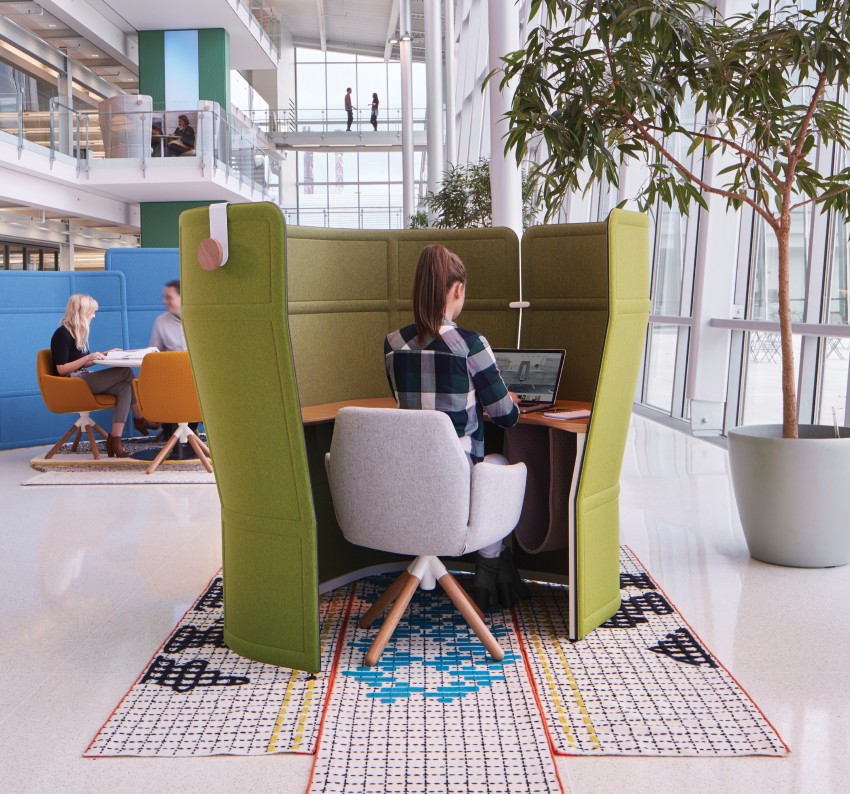
Haworth Inc., a family-owned company that serves markets in more than 120 countries through a global network of 600 dealers, manufactures products that transform spaces. The company recently celebrated its 70th anniversary.
the way we work
A productive day at work—it’s a great feeling.
When you tick through your to-do list, work toward common goals and collaborate in meaningful ways, you feel good about your work and your organization. You leave the office feeling buoyant and fulfilled. You reach home able to focus on what fuels you outside the workplace, and you look forward to your next workday.
The productive workday isn’t an accident. It’s the product of many things: leadership, culture and hiring, among others. It’s also impacted by your workspace itself and whether it is optimally designed so that you can be your most productive work self.
For more than 70 years, Haworth Inc. has been tackling the challenge of designing workspaces that help maximize productivity, control real estate costs through space utilization and reflect organizational culture.
How does Haworth do it?
“We look at what science tells us,” says Global Design Director Jeff Reuschel, B.S.’81. “The reason we firmly ground our design process in science is that it is so easy to rely on experience versus expertise. Experience doesn’t tell you everything—experience can be a 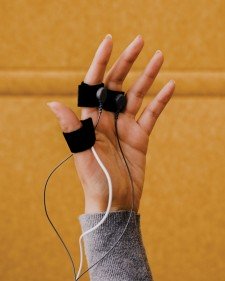 snapshot or a limited view. Expertise is what allows you to predict what is most likely to happen for most people if a product is designed in a certain way.” The scientific approach allows Haworth to keep fundamental human tendencies or traits at the forefront of their design when creating solutions. “There are some things that are universal and work effectively for the way the human body and mind are made to respond,” says Reuschel.
snapshot or a limited view. Expertise is what allows you to predict what is most likely to happen for most people if a product is designed in a certain way.” The scientific approach allows Haworth to keep fundamental human tendencies or traits at the forefront of their design when creating solutions. “There are some things that are universal and work effectively for the way the human body and mind are made to respond,” says Reuschel.
This allows the Haworth team to be creative within a set of parameters, which ensure better concentration and comfort in the work environment. Haworth has insights on everything from how visual and auditory disturbances affect people’s ability to complete work effectively to the ideal proximity for employees working in shared spaces.
Reuschel notes that in recent years employers have shifted their perspective on workspace. “In the past, space was considered a necessary part of the business, but not typically looked at as an asset. With more research, changes in our industry and evolving business practices around the world, people are seeing the benefits of properly designed space, and there is renewed interest in space as something that matters. For me, this shift feels long overdue. Businesses are seeing how workspaces can support productivity, job satisfaction and corporate culture. We are seeing profound changes in the value organizations are placing on space, and not just from a cost perspective.”
Employee engagement is central to Haworth’s design process. “We start with the person,” says Global Brand Director Kurt Vander Schuur, MBA ’99, “We look at what it takes for a person to have well-being physically, mentally and emotionally. We have a lot of evidence that shows that happiness at work is key to employee fulfillment and retention. While a workspace doesn’t create happiness at work, there are many things that workspace can improve for the employee, and we relish helping our customers create better work environments.”
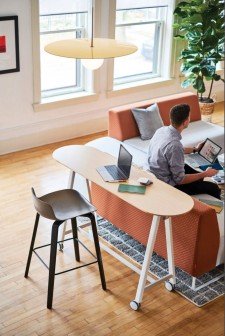 One of the challenges in work environments is being able to keep workspaces relevant and contemporary as the way we work evolves.
One of the challenges in work environments is being able to keep workspaces relevant and contemporary as the way we work evolves.
Adaptability is the central tenant of Haworth’s Organic Workspace, an approach to designing workspaces and products, which anticipates this challenge and enables spaces to be reconfigured as business needs change. Organic Workspace begins with the individual and their needs. It then accounts for team dynamics. It then analyzes the real estate use for the organization and evaluates what is essential for the continued success of that organization.
Regular feedback on space use, work patterns and workforce measures, such as engagement, wellness and efficiency, keep the design aligned with business goals.
Working with customers on this alignment is what Chris Tornblom, B.B.A.’98, director of strategic accounts, enjoys most. “Working with companies as a trusted advisor is the ideal scenario and that involves knowing quite a bit about their business and how to have the maximum, positive impact.”
Tornblom’s unit is dedicated to working with businesses to identify their key needs and then working with them in this advisory capacity.
“Companies should be asking, ‘What is our culture today and what do we want it to be?’” says Vander Schuur. “Once a company has done a thorough assessment of its culture and the sub-cultures of its units, we can assist with design expertise to support the organization’s cultural goals.”
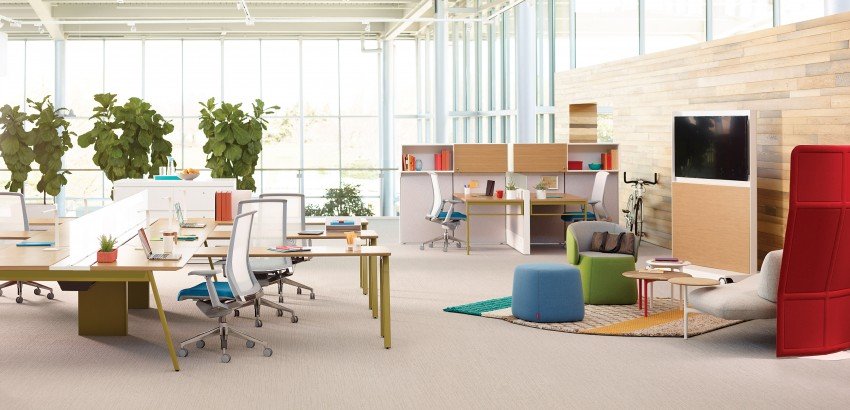
The open floor plan has become increasingly popular in the modern workplace. An open concept works best when a variety of needs are addressed. Key to the success of the open concept is the understanding that there are spaces for private conversations and zones where auditory or visual disturbances are minimized.
Haworth itself is a good case study in matching design with culture. Prior to the 2008 opening of its new headquarters, One Haworth Center, the company had many more areas devoted to individual workspaces than to collaborative spaces, yet the company valued collaboration, innovation and interaction. Haworth went from having about 90% individual spaces and 10% collaborative spaces to 40% individual spaces and 60% collaborative spaces. “I am the first person to say that the culture of a company comes from within,” says Vander Schuur. “Haworth can’t establish culture, but it can help promote values and behaviors through use of space.”
Haworth’s culture is one of the things that defines the organization, which may explain why its professionals are so good at talking with customers about their corporate cultures. “Haworth really is a family,” says Vander Schuur. “When you work at Haworth, you have a sense of belonging. The entrepreneurial spirit and inventiveness of Haworth also stand out. I think you can trace an emphasis on taking calculated risks and learning from mistakes back to the Haworth family. G.W. Haworth was an educator before founding the company and built a culture of people who value learning to become better problem solvers, and that has certainly been carried on through Dick and Matthew Haworth.”
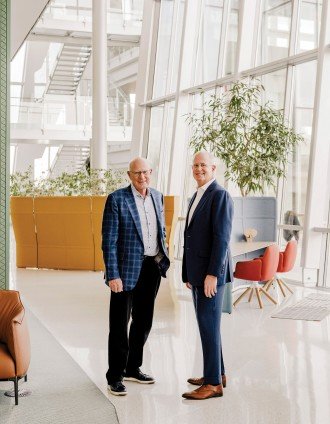
Dick Haworth introduced the Haworth Values—a clearly articulated set of principles that underpins all that Haworth does and fosters its culture through each person in the organization.
“Our values are much more than words on a page,” says Dick Haworth, chairman emeritus of Haworth Inc. “We hold them up as goals to stretch for every day. I believe that our values are the most important contribution I have made to the company, as these enduring qualities guide our business and align us to our customers. They are taken to heart by our entire family of employees across the globe.”
Tornblom, who started as an intern at Haworth in the late ’90s, notes, “There is a warmth to Haworth that is unique. For me, as an employee, I can advance as far as I can think. The company asks for my best thinking, and that, in turn, creates opportunity.”
And culture helps to cut through the clutter. “It’s vitally important for us to look ahead to the future,” says Matthew Haworth, chairman. “We explore what will shape where we will be in 5, 10, or even 50 years. However, there are many unknowns in the future. The one thing we do know is that change is a constant. Since change and evolution are a given, the values that an organization lives by are extremely important and help guide how it makes decisions and reacts to change. Continuous discussion of values with all stakeholders is critical, as is making sure that those values are at the forefront of decisions.”
- Future focus
What are the professionals at Haworth looking at in terms of the future trends in the workplace?
- Power
“Power is always a key consideration in design,” notes Reuschel. “I am very interested to see how things progress as battery life of devices becomes better. We haven’t scratched the surface of what will become possible as that particular technology advances.”
- Working remotely
How much is too much when it comes to working remotely? That is a question most organizations are currently trying to answer. “Many customers are trying to find the right balance as real estate costs, employees’ desire for flexibility and the need for face time drive the conversation,” says Tornblom.
- The speed of change
“Change is a constant and the pace of change is getting faster and faster,” says Vander Schuur. “As we think about space, we need to embrace change. People are rethinking their interaction with everyday items—the sharing economy is a great example of this. I am excited to see where new concepts take us. We are living in an exciting time.”
Research snapshot: sitting pretty
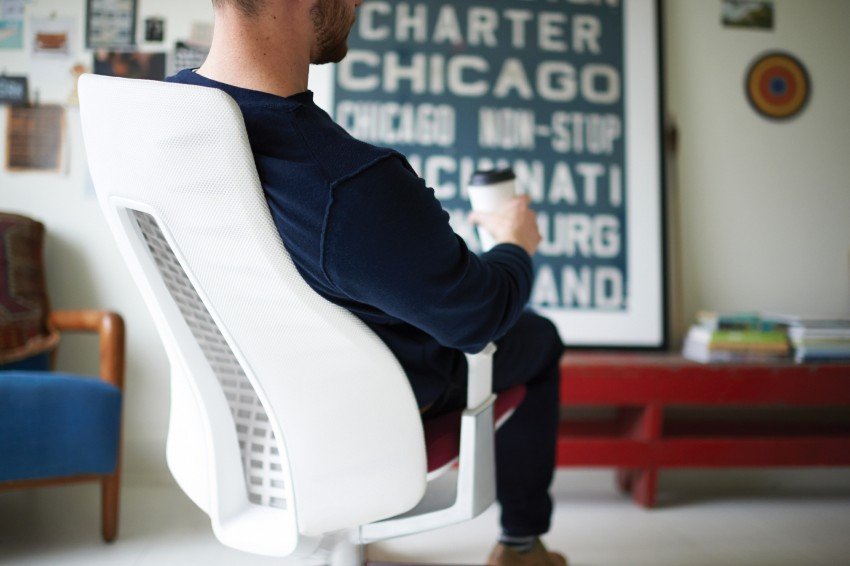
There is no doubt that Haworth’s Fern chair is aesthetically pleasing. Designed as an adjustable office chair without levers and knobs, its simple elegance can be deceiving. Behind Fern’s pleasing forms are 5.5 billion data points, collected by Haworth’s researchers and members of the Human Performance Institute at WMU’s College of Engineering and Applied Sciences.
Teresa Bellingar, the senior corporate ergonomist at Haworth, began a relationship with WMU 16 years ago to collaborate on a variety of research projects. “WMU has always been willing to talk with me about doing research in different ways to get better results,” she says.
For example, a past project involved determining how lumbar support should be provided in Haworth chairs. “The research wasn’t clear on what was best,” she notes. The result of that research was Haworth’s Zody chair—its best-selling task chair—which allows users to dial in the level of lumbar support they would like and provides asymmetrical support that reflects the natural asymmetry most bodies have.
 With Fern, the data was used in a different manner, going beyond its original use case and answering the question, “Even if a chair does not have adjustable lumbar support, how much support do people want in that area?”
With Fern, the data was used in a different manner, going beyond its original use case and answering the question, “Even if a chair does not have adjustable lumbar support, how much support do people want in that area?”
Haworth uses snapshots of data from a range of people who sit in chairs for just a few seconds. Sensors record how each sitter reacts to different variables, and the analysis of the final data predicts how someone will feel after sitting in the chair for hours. Will the sitter’s back be sore … will their arms be comfortably placed … will the materials on the chair cause them to be too warm? In the end, Haworth is able to validate each product and continuously improve its product offerings.
“How we interact with our work environment is so important to doing good work,” says Bellingar. “Mobility will continue to be a prime consideration for offices. We know how important movement is to health, so when we design workspaces, we are always trying to think of that. How do we get people to focus on their work yet change their posture more often? Health and wellness will continue to drive design. If employees are not healthy, it affects their ability to do their jobs and to be productive.”
